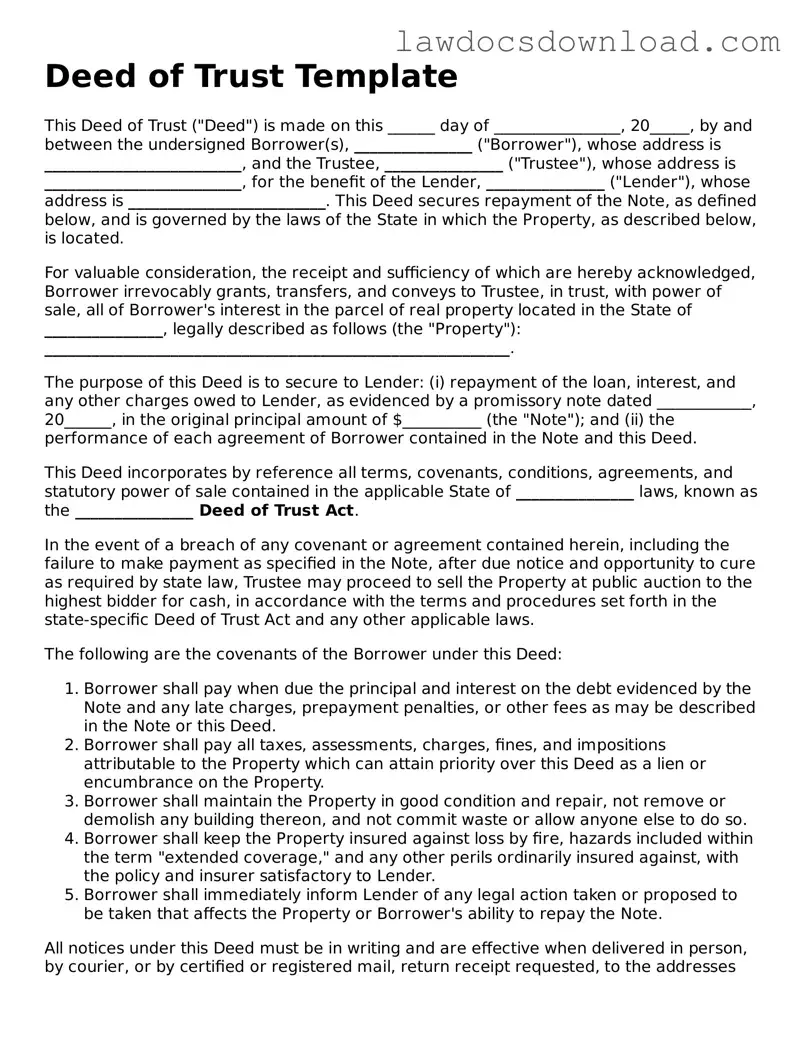Deed of Trust Template
This Deed of Trust ("Deed") is made on this ______ day of ________________, 20_____, by and between the undersigned Borrower(s), _______________ ("Borrower"), whose address is _________________________, and the Trustee, _______________ ("Trustee"), whose address is _________________________, for the benefit of the Lender, _______________ ("Lender"), whose address is _________________________. This Deed secures repayment of the Note, as defined below, and is governed by the laws of the State in which the Property, as described below, is located.
For valuable consideration, the receipt and sufficiency of which are hereby acknowledged, Borrower irrevocably grants, transfers, and conveys to Trustee, in trust, with power of sale, all of Borrower's interest in the parcel of real property located in the State of _______________, legally described as follows (the "Property"): ___________________________________________________________.
The purpose of this Deed is to secure to Lender: (i) repayment of the loan, interest, and any other charges owed to Lender, as evidenced by a promissory note dated ____________, 20______, in the original principal amount of $__________ (the "Note"); and (ii) the performance of each agreement of Borrower contained in the Note and this Deed.
This Deed incorporates by reference all terms, covenants, conditions, agreements, and statutory power of sale contained in the applicable State of _______________ laws, known as the _______________ Deed of Trust Act.
In the event of a breach of any covenant or agreement contained herein, including the failure to make payment as specified in the Note, after due notice and opportunity to cure as required by state law, Trustee may proceed to sell the Property at public auction to the highest bidder for cash, in accordance with the terms and procedures set forth in the state-specific Deed of Trust Act and any other applicable laws.
The following are the covenants of the Borrower under this Deed:
- Borrower shall pay when due the principal and interest on the debt evidenced by the Note and any late charges, prepayment penalties, or other fees as may be described in the Note or this Deed.
- Borrower shall pay all taxes, assessments, charges, fines, and impositions attributable to the Property which can attain priority over this Deed as a lien or encumbrance on the Property.
- Borrower shall maintain the Property in good condition and repair, not remove or demolish any building thereon, and not commit waste or allow anyone else to do so.
- Borrower shall keep the Property insured against loss by fire, hazards included within the term "extended coverage," and any other perils ordinarily insured against, with the policy and insurer satisfactory to Lender.
- Borrower shall immediately inform Lender of any legal action taken or proposed to be taken that affects the Property or Borrower's ability to repay the Note.
All notices under this Deed must be in writing and are effective when delivered in person, by courier, or by certified or registered mail, return receipt requested, to the addresses specified above, or to such other addresses as any party may designate by notice to the other parties.
This Deed, together with the Note, represents the entire agreement between the parties concerning the subject matter hereof and supersedes all prior agreements, understandings, negotiations, and discussions, whether oral or written. This Deed may only be amended, modified, repealed, or waived by a written instrument signed by the parties hereto.
IN WITNESS WHEREOF, the parties hereto have executed this Deed of Trust as of the date first above written.
___________________________________
Borrower Signature
___________________________________
Trustee Signature
___________________________________
Lender Signature
